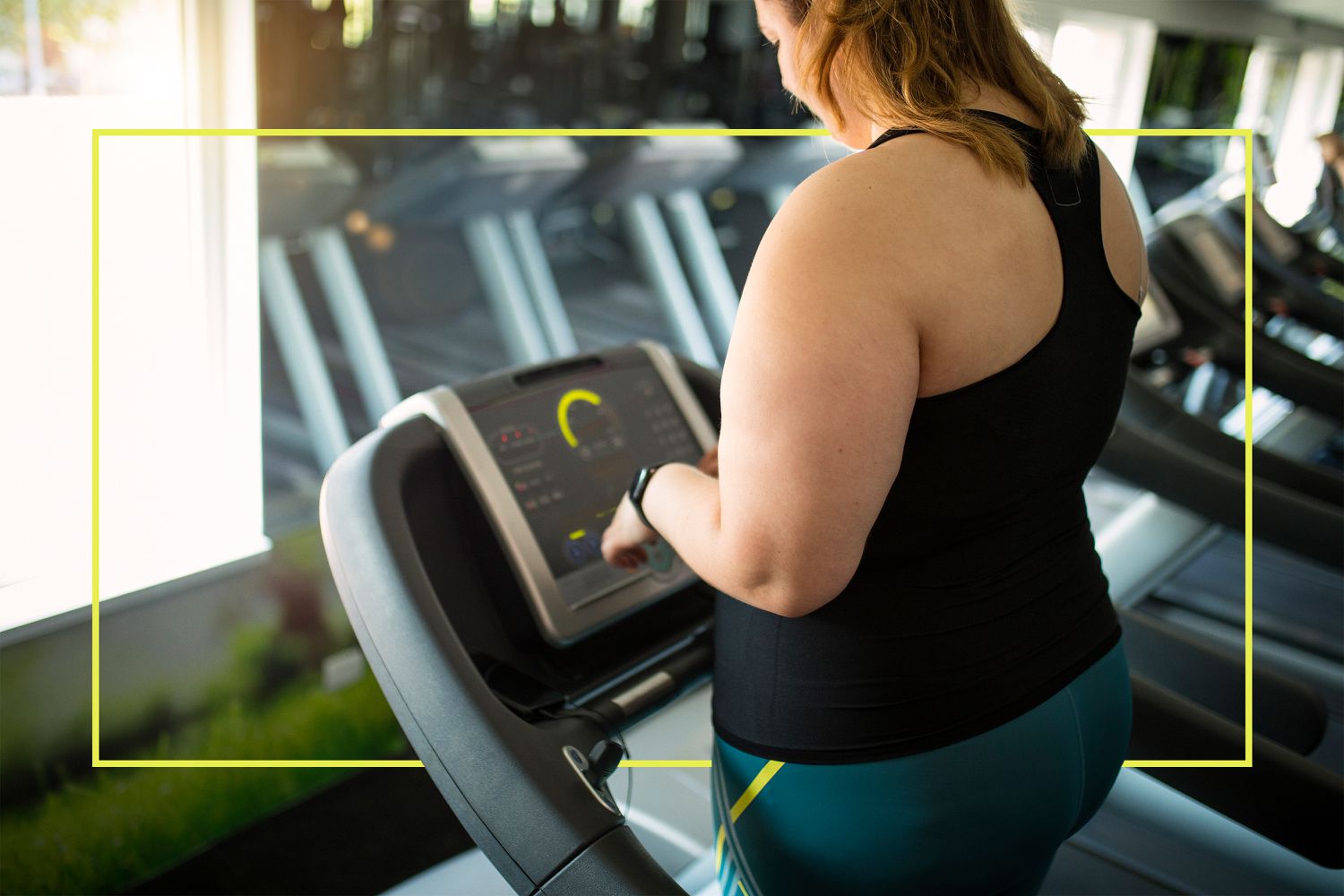"How to Add Excitement to Treadmill Running: 10 Fun Methods"

Do you find your treadmill sessions as exciting as waiting on a computer to update, listening to hold music, or hearing about someone's high school triumphs? If yes, you're not exercising correctly! While your workouts may not always be as fascinating as a post-match conversation with your best friend or people-watching at your frequented date spot, they should definitely not be dreary. Your time on the treadmill or any gym equipment should not be monotonous.
Luckily, if your treadmill exercises are beginning to feel more sluggish than exciting, there are several tweaks you can apply to make them thrilling once more. Kris Rugloski, an expert in running and obstacle races and a top contender with HYROX, insists, “Treadmill exercises can be made exciting in numerous ways. Your treadmill run will only be as tedious as you make it.”
Ready to banish boredom? Continue reading. We've collected an array of trainer-backed strategies to exchange treadmill tedium for variety!
Were you raised in a dance studio? Renowned for dominating the music selection during car rides? Love creating personal playlists? If your answer to any of these questions is affirmative — or if you simply enjoy music — this advice is for you.
Have you heard of the treadmill strut that's famous on TikTok, which became viral thanks to genius Allie Bennett? It incorporates walking on the treadmill in time with the tune playing on your AirPods. Bennett tells Shape, “Having your favourite music playing while working out on the treadmill is not only motivating but also boosts your confidence at the gym.”
You can experiment with it by downloading one of Bennett’s Spotify playlists, such as The Original Taylor Swift Strut, Disney Channel Strut, or Emo Treadmill Strut. Then, try to match your walking pace with the rhythm. Don't hesitate to imagine you're gracing the New York Fashion Week runway as you strut, sashay, or stride. Bennett suggests waving to your 'fans' or striking a pose. “Channeling your inner runway model can be much more empowering than you’d expect.”
It's likely you've heard of high-intensity interval training (HIIT) unless you've been living under a treadmill-shaped rock. To summarise, HIIT involves alternating periods of extremely high-intensity exercise with rest and recovery periods. It is essentially the polar opposite of a slow, shake-out jog, explains fitness professional Heather Grace Kaschak, a Barry's instructor in Chicago, IL.
“HIIT offers several benefits, such as improved muscle strength, endurance, agility, and most importantly, calorie burn,” Kaschak clarifies. Because this training style involves oscillating between varying speeds and inclines, interval training is a lot more mentally engaging than a steady-state run. In essence, say goodbye to boredom and hello to intensity!
Most treadmills feature several pre-set, interval-style workouts. These can be a fantastic way to familiarise yourself with this training format. If your treadmill lacks that option, or you've exhausted available options, you might try doing a series of the following interval running workouts:
It's worth noting: Due to the high intensity and consequent stress on the body, Kaschak recommends that most individuals should limit HIIT to a maximum of 3 to 4 times per week. On other days, you might opt for a steady-state run or strength training depending on your fitness objectives.
Do you usually enjoy treadmill sessions but have recently found them unexciting? An absence of specific fitness goals could be the culprit. According to Kaschak, “Setting a goal is crucial for maintaining motivation and interest in your workouts and exercise regimes.” When goals are realistic and precise, recalling your long-term objectives can help rekindle your energy on days you’re feeling uninspired about exercising.
Remember: There are numerous health and fitness advantages of using the treadmill, including enhanced cardiovascular health, strengthened leg muscles, better body awareness, and greater mental toughness. All of these contribute to better performance in sports other than just walking and running. Hence, your health and fitness objectives need not be restricted to running. Your goal could be to complete a marathon, Kaschak suggests, or to surpass your previous best at deadlift.
If you are uncertain about your fitness objectives, consider asking yourself the following questions:
Besides setting long-term objectives, Kaschak suggests that it can also be motivating to establish a specific goal for the upcoming treadmill session. “Entering your session with a target like ‘I want to jog faster than yesterday’ or ‘I want to stay on the treadmill 5 minutes longer today’ can help maintain your motivation,” she adds.
Consider making a daily goal around your emotional and mental states while using the machine. For example, you might aim to maintain a positive internal dialogue, even when you're feeling uninterested on the treadmill. Or you might decide to be gentle with yourself if your pace isn't as fast, particularly on those days when you're not feeling your best.
The purpose of these daily targets isn't to make you feel like you're not meeting some impossible criteria, but rather it's meant to keep your focus on the activity at hand. As she pointed out, it's crucial not to put too much pressure on yourself if you fall short in reaching a certain goal. Moreover, there will be plenty of other opportunities in the future to succeed at it, such as your next treadmill session!
Why squander your preferred TV serials on a Netflix & Chill outing with a dull right swipe when you could make the most of them during your workout? According to Kaschak, watching your favourite shows while on the treadmill can make for an enjoyable workout the length of a TV episode.
Viewing TV or a movie can be an effective distraction during your workout, as it helps to create a positive connection between physical exercise on the treadmill and entertainment. Based on a 2016 study that appeared in the Journal of Sports Science and Medicine, it was discovered that watching television during exercise increased the overall enjoyment of the exercise.
However, watching TV while on the treadmill can shift your focus from your strides to the screen, which can lead to accidents like tripping during your run. To keep safe, make sure you're adequately familiar with the treadmill before combining workout and watching TV. According to Kaschak, it is quite fine to have a relaxed treadmill session while watching TV. Since watching TV is a leisure activity, adjust your speed to find a comfortable balance.
Kaschak also recommends incorporating some backward walking into your treadmill routine, either as part of your warm-up or in the course of the workout itself. This unique exercise activates and strengthens the quadriceps, calves, and shins, which are essential for running. Starting your run with a bit of backward walking could help in readying your muscles for the intensive workout.
This exercise also applies lesser force on the knee per step as compared to walking forward, Kaschak points out. Hence, it can serve as a good rehabilitation exercise for people with pre-existing knee ailments. For safety, ensure to keep a hold of the railings and employ a slow speed.
Please note that not all treadmills provide the facility to walk backward, in the words of Rugloski. She adds that even if your treadmill doesn't allow you to move backward manually, you can simply include five minutes of backward walking in your regular workout to reap the same benefits on your tendons and ligaments.
While most exercise routines and fitness sessions primarily involve forward or backward movements, lateral moves are also beneficial. Kaschak explains that treadmill-based lateral movements help in strengthening your hip abductors and adductors, which are overlooked in run-only workouts. Evidence suggests these groups of muscles help in maintaining pelvic balance which boosts stability, mobility, flexibility, and sporting performance.
Your next step could be to walk or shuffle on the treadmill sideways for an equal amount of time in both directions. This helps in gaining balanced strength and mobility in both sides and reduces the risk of muscle compensation that can result in discomfort, pain, and injuries in the long run.
The days when the Nike Tempo Running Short was the only essential item for running are long gone. If you're more comfortable sticking to your regular running wear, that's totally fine!
But don’t underestimate how motivating it can feel to slip into something a little more fashion-forward before getting your sweat on. Indeed, Bennett says wearing a fun gym outside really helps get her excited about her workouts. “It may sound silly, but whatever gets you moving consistently is always the best option.”
If you’re currently on the market for some new workout wear, we recommend these Lululemon Leggings or these ones from Gymshark.
On the flip side, if the lack of a designated workout wardrobe is keeping you out of the gym, consider giving cozy cardio a whirl. Another trend popular on FitTok, cozy cardio involves working out in whatever outfit and in whatever way feels best to you! For individuals who don’t go to the gym because of fear that they don’t have the proper workout attire, or won’t look cute enough, adapting a cozy cardio mindset can be powerful.
The Founder of the Cozy Cardio Club, Hope Zuckerbrow, hits her treadmill (or walking pad) in pajamas. But really, anything goes — just be sure to read your gym’s dress code ahead of time, as some gyms do not allow you to exercise in just a sports bra, while others forbid exercising in jeans.
No doubt, treadmills are a great way to get your run in when you need to train indoors, don’t have access to child or pet care, or are limited on time. But don’t forget about nature’s treadmill (AKA the outdoors).
Rugloski is a proponent of running outdoors wherever possible — especially if your training is starting to feel boring day after day after day. “There are so many benefits of being outside in the fresh air and sunshine,” she says.
Plus, many races take place outdoors as opposed to inside,” she says, which can make outdoor training a smidge more transferable on race day.




